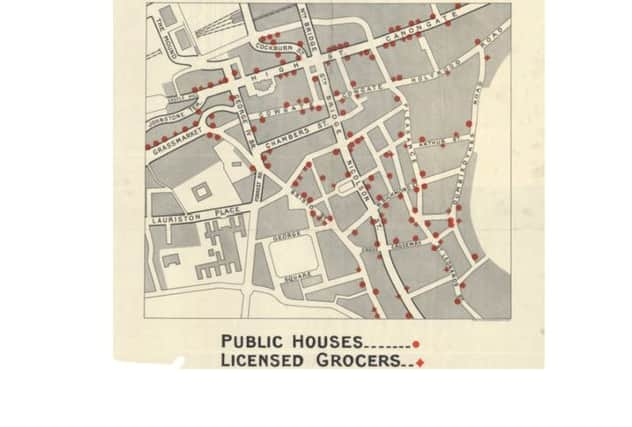1923 map shows every pub in Old Town Edinburgh


The propaganda map was commissioned by the Temperance movement for a ward election in December 1923 to decide if the city centre was to go “dry.”
Five hundred copies of the poster were plastered on walls at polling stations at a time when temperance movement was at its most powerful.
Advertisement
Hide AdProduced by Bartholomew’s, the Edinburgh-based family firm of mapmakers, the stark red symbolism of the symbols on a plain background of streets in a densely populated Old Town and south side, home to many immigrants, creates a very striking graphic and sends out a clear message of disapproval.
The booze map is among a variety of 70 cartographic works covering the past 500 years in a new book “Edinburgh, Mapping the City” by Christopher Fleet and Daniel MacCannell which aims to show the political and social life of the city rather than merely maps for following directions.
Mr Fleet, maps curator at the National Library of Scotland, said the had been very cleverly constructed and used “subliminal” techniques to get its message across.
“The colour red has been deliberately chosen to represent danger and show the concentration of places where drink could be consumed from an off-licence or pub. It could have been done without making it seems so dangerous and alarming.
“A lot of the topographic detail, including some of the street names and buildings are not there but those that are there are instantly recognisable as being the Old Town. It didn’t need street names for the locals it was aimed at to get the message that ‘Edinburgh was awash with drink.”
Mr Fleet, whose book includes maps showing the prevalence of tuberculosis in the city to current day digital mapping, added: “Maps are political and they need to distort or exclude some features to get their message across.
Advertisement
Hide Ad“The aim was to get people to think and act in a different way rather than finding their way from A to B.”
Just one month before polling day Duncan Maclennan, chairman of the Edinburgh Citizens ‘No Licence’ Council made a rousing speech in support of prohibition where he announced that the people of Scotland would soon grow tired of seeing ‘the wheels of the chariot of their deliverance stuck in a bog of their self-indulgence.”
Advertisement
Hide AdHowever, the temperance campaign was unsuccessful with the turnout for ‘No Change’ growing slightly to 68 per cent, with only 29 per cent in favour of ‘No Licence’.
During the First World War the consumption of alcohol was increasingly presented as unpatriotic, and, coupled with religious criticism and high taxes, the way was paved for complete prohibition in countries such as the United States, Finland and Norway.
But the drive for abstinence went into dramatic decline in the 1930s and after the Second World War the global movement was superseded by the war against illegal drugs.
• Edinburgh: Mapping the City, by Christopher Fleet and Daniel MacCannell. Published by Birlinn, £30.